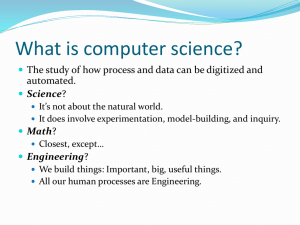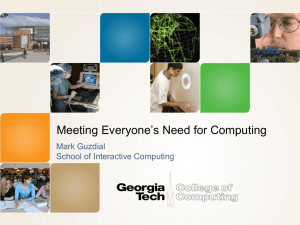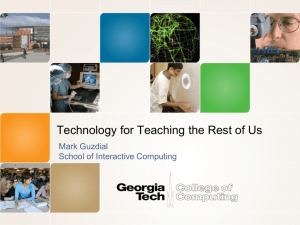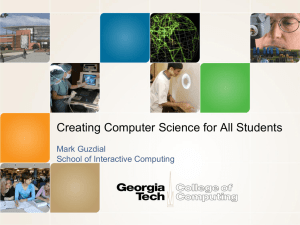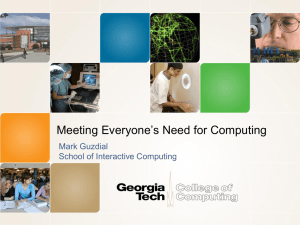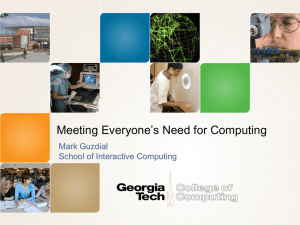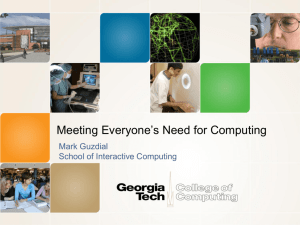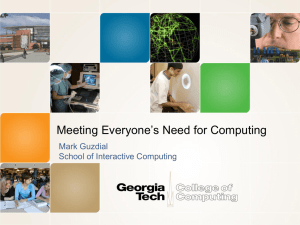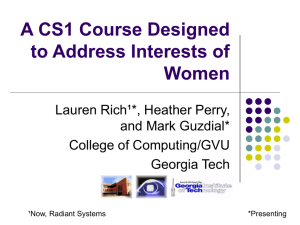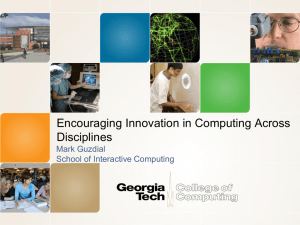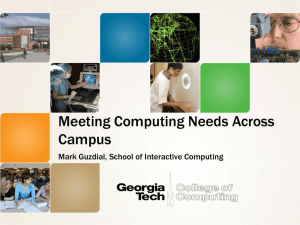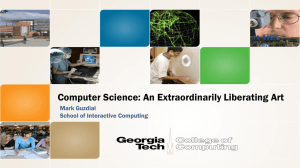TTU-Tapestry-July2011
advertisement
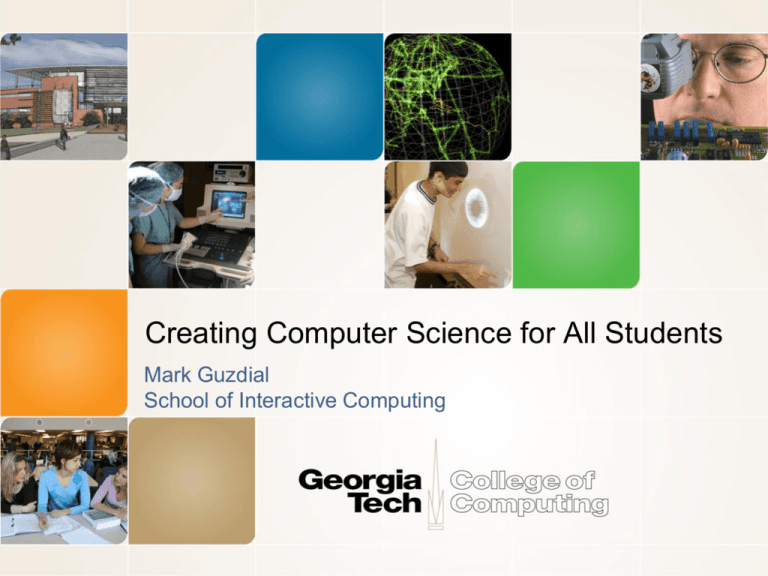
Creating Computer Science for All Students Mark Guzdial School of Interactive Computing Story • Computing is important for more than just those who choose to major in computing. • Computing is key to innovation for far more than our majors. • Part 1: The History of Teaching Computing to “All” • Part 2: Do they “all” want what we have? If so, why don’t they take computer science classes? • Part 3: How do we teach those who do not want to become software engineers or computer scientists? • Computing for All at Georgia Tech • 1999-2003: One course for all • 2003-2008: Contextualized Computing Education The Two Cultures The typical CS student: Future Software Engineer • To produce reliable, robust, secure software. • To work in interdisciplinary teams. • To use appropriate design notations, such as UML. • To work in multiple programming languages. 4 Taulbee Numbers 2010 CRA Taulbee Survey of PhD-granting institutions Who wants what CS has to offer? • Computing is at the core of the modern society and modern economy. • Computing is key to innovation in many disciplines. • Computer Science has a much larger potential audience beyond software developers. • Estimates: ~13 million non-professional programmer/end-user programmers in US by 2012, vs. ~3 million professional software developers (Scaffidi, Shaw, & Myers, 2005) 6 An atypical CS student: Computational scientist or engineer • To use computation as a tool to enhance understanding. • To write programs of (at most) 100 lines (most often, 10 lines) for themselves. • They care about the products of the programs, not the programs. • To learn as few languages as are needed for their tasks. • To work in interdisciplinary teams, including software engineers. 7 An atypical CS student: Secondary/High School CS teacher • To use code to explore and understand ideas of computation. • To learn what languages are necessary to meet standards and engage students. • To work with students with a wide range of interests. • Probably won’t work with professional software engineers 8 An atypical CS student: Graphics designer • To write programs to improve their efficiency, and to implement their dynamic (e.g., Web) designs. • To do as little coding as possible. • To learn about computing ideas in order to improve their process, but with a focus on people and creativity. • Probably won’t work with professional software engineers 9 How do meet this need? • Our track record for the first CS course is poor. • 30-50% failure or withdrawal rates (Bennedsen & Caspersen, 2007) • Other majors tend to be more female and more ethnically diverse than the typical computing student. • If we can’t succeed in the first course with people who want to major in CS, how do we teach others? • Different motivations and goals, and different tools and languages. 10 Where my argument is focusing K-12 Postsecondary Professional life • K-12 is where we typically aim to teach everyone. • At the undergraduate level, we can show that computing connects to students’ career goals. • Professionals find that they need computing, after their formal education is finished. 11 Three points in this space • Part 1: Historical: Should CS be teaching computing to everybody? • Part 2: Do students need education about computing? What’s the cost of not learning about computing? • Part 3: How do we teach everyone? What methods do we use? Not part of today’s story: - Where do we get the trained teachers? (HUGE issue!) - How should we change high school CS? 12 1961 MIT Sloan School Symposium Learn Programming to Re-Think Process Everywhere • Alan Perlis argued that computer science should be part of a liberal education. – Explicitly, he argued that all students should learn to program. • Why? – Because Computer Science is the study of process. – Automated execution of process changes everything • Including how we think about things we already know Does it have to be programming? • Elias: If the computers, together with sufficiently ingenious languages and programming systems, are capable of doing everything that Professor Perlis describes—and I believe they are (and more)—then they should be ingenious enough to do it without the human symbiote being obliged to perform the mechanical chores which are a huge part of current programming effort, and which are a large part of what must now be taught in the introductory course that he proposes. 15 Why programming? • Licklider: Peter, I think the first apes who tried to talk with one another decided that learning language was a dreadful bore…But some people write poetry in the language we speak. • Perlis: The purpose of a course in programming is to teach people how to construct and analyze processes…A course in programming is concerned with abstraction: the abstraction of constructing, analyzing, and describing processes…The point is to make the students construct complex processes out of simpler ones….A properly designed programming course will develop these abilities better than any other course. 16 The Power and Fear of Algorithms • The Economist (Sept., 2007) spoke to the algorithms that control us, yet we don’t understand. • Credit Ratings, Adjustable Rate Mortgages, Search Rankings • C.P. Snow foresaw this in 1961. • Those who don’t understand algorithms, can’t understand how the decisions are made. “A handful of people, having no relation to the will of society, having no communication with the rest of society, will be taking decisions in secret which are going to affect our lives in the deepest sense.” Alan Kay’s Dynabook (~1970) •Alan Kay (2004 ACM Turing Awardee) sees the Computer as humanity’s first metamedium • A medium that can represent all other media. • Programming as an important new medium •The computer-asDynabook is for creative metamedia exploration and reading Richard Dawkins on Biology as Computer Science • On US National Public Radio in April 2007: • GROSS: You close your book saying, "I am thrilled to be alive at a time when humanity is pushing against the limits of understanding." How do you think that's happening in your field of evolutionary biology? • Mr. DAWKINS: Well, it's the most exciting time to be a biologist… Since Watson and Crick in 1953, biology has become a sort of branch of computer science. I mean, genes are just long computer tapes, and they use a code which is just another kind of computer code. It's quaternary rather than binary, but it's read in a sequential way just like a computer tape. It's transcribed. It's copied and pasted. All the familiar metaphors from computer science fit. Why teach computing to everyone? • Perlis: To have a powerful new tool to think with. • Snow: Because it’s necessary to participate and understand in the modern world. • Kay: To have full expressive power with the most powerful and creative medium humans have ever invented. • Dawkins (and Jeanette Wing): To provide powerful computing metaphors to think with. 20 Part 2: Do they want or need what we have to offer? • Brian Dorn has been studying professional graphics designers who program. • Conducted a series of interviews and assessment activities. • Found that these subjects want more computer science, but don’t find CS courses adequate (ICER, 2010) P10: So, that was a really long way of saying yes, I think that an academic study would make me a better programmer, but not by a whole lot. 21 What do software engineers do? Answer: The Boring Stuff. • P2: I was able to take different samples from different places and instead of just being let's say an MIS major, or computer science major, you know it's—you're not going to be front-end anything with computer science. You're going to be back-end everything. • P4: I think as a front-end developer, you focus more on the design and the usability, and you're focusing more on the audience. And then on the back-end I think you're focused on more, these are like the software developers. And they're programming something, and they don't really see what it's gonna look like; they're just making it work. 22 Who is in CS? • As Yardi and Bruckman (ICER 2007) found, participants held negative stereotypes of those in CS: • P2: I went to a meeting for some kind of programmers, something or other. And they were OLD, and they were nerdy, and they were boring! And I'm like, this is not my personality. Like I can't work with people like that. And they worked at like IBM, or places like that. They've been doing, they were working with Pascal. And I didn’t…I couldn't see myself in that lifestyle for that long. • P5: I don't know a whole ton of programmers, but the ones I know, they enjoy seeing them type up all these numbers and stuff and what it makes things do. Um, whereas I just do it, to get it done and to get paid. To be honest. The design aspect is what really interests me a lot more. 23 Why don’t they take CS classes? • P7: I started out in computer science, but didn't like it at all. The fact that I wasn't learning anything new. I took an intro to programming course, and then I talked to some other people in the program and it was all repetition and I guess there wasn't any really new. So you weren't really learning any concepts. You were learning the languages, and I didn't like that at all. So that's why I left… • Do we just teach languages? Why don’t they see the concepts? 24 They are not afraid of coding • “What interests you about web design?” • P12: The coding! I don't like to code. But the things that the code can do is amazing, like you can come up with this and voila, you know, it's there. Javascript for one. The plugins and stuff. I think that's very interesting, intriguing and stuff. Because I mean like the code is just, there's so much you can do with code and stuff. It's just like wow. 25 They’re Lost without Initial Knowledge • They learn from websites, reading lots of code, books where they can, friends. • Rarely courses. • Surprising tidbit: Learning less than they might because of a lack of deep knowledge. • For example: Exploring code by searching Google for function and variable names. • Brian’s experiment: Given a case library with conceptual information vs. a code repository alone, what gets learned, used, and liked? (ICER 2011) 27 Bottomline: Cases work • They like the cases. • They code the same. • Case-users learn the concepts, while repository users do not. • Suggests how we might help non-CS professionals who discover computing late. 28 Part 3: Teaching Computing to Everyone • Fall 1999: All students at Georgia Tech must take a course in computer science. • Considered part of General Education, like mathematics, social science, humanities… • 1999-2003: Only one course met the requirement. • Shackelford’s pseudocode approach in 1999 • Later Scheme: How to Design Programs (MIT Press) One-class CS1: Pass (A, B, or C) vs. WDF (Withdrawal, D or F) Success Rates in CS1 from Fall 1999 to Spring 2002 (Overall: 78%) Architecture 46.7% Biology 64.4% Economics 53.5% History 46.5% Management 48.5% Public Policy 47.9% Contextualized Computing Education • What’s going on? – Research results: Computing is “tedious, boring, irrelevant” • Since Spring 2003, Georgia Tech teaches three introductory CS courses. – Based on Margolis and Fisher’s “alternative paths” • Each course introduces computing using a context (examples, homework assignments, lecture discussion) relevant to majors. – Make computing relevant by teaching it in terms of what computers are good for (from the students’ perspective) Our Three CS1’s Today • CS1301/1321 Introduction to Computing Traditional CS1 for our CS majors and Science majors (math, physics, psychology, etc.). Now, uses robots. • CS1371 Computing for Engineers CS1 for Engineers. Same topics as CS1301, but using MATLAB with Engineering problems. • CS1315 Introduction to Media Computation for Architecture, Management, and Liberal Arts students. 32 Media Computation: Teaching in a Relevant Context •Presenting CS topics with media projects and examples – Iteration as creating negative and grayscale images – Indexing in a range as removing redeye – Algorithms for blending both images and sounds – Linked lists as song fragments woven to make music – Information encodings as sound visualizations 33 def clearRed(picture): for pixel in getPixels(picture): setRed(pixel,0) def greyscale(picture): for p in getPixels(picture): redness=getRed(p) greenness=getGreen(p) blueness=getBlue(p) luminance=(redness+blueness+greenness)/3 setColor(p, makeColor(luminance,luminance,luminance)) def negative(picture): for px in getPixels(picture): red=getRed(px) green=getGreen(px) blue=getBlue(px) negColor=makeColor(255-red,255-green,255-blue) setColor(px,negColor) Open-ended, contextualized homework in Media Computation CS1 Composed sound Sound collage Linked list canon 35 Results:CS1“Media Computation” Change in Success rates in CS1 “Media 12.540% 10.270% 14.650% 9.370% 7.580% 11.410% 19.650% 17.100% Computation” from Spring 2003 to Fall 2005 22.540% (Overall 85%) Architecture 46.7% 85.7% 86.470% 88.360% 84.710% 89.870% 91.940% 87.500% Biology 64.4% Economics 54.5% 92.0% History 46.5% 67.6% Total Females Males Fall03 Fall03 Fall03 Management Public Policy Total Females Males Sp04 Sp04 Sp04 48.5% 47.9% 90.4% 80.330% 82.900% 77.460% Total Females Males Fall04 Fall04 Fall04 87.8% 85.4% WDF Pass Was the class successful? • Interviewed Intl Affairs student (female): “I just wish I had more time to play around with that and make neat effects. But JES [IDE for class] will be on my computer forever, so… that’s the nice thing about this class is that you could go as deep into the homework as you wanted. So, I’d turn it in and then me and my roommate would do more after to see what we could do with it.” • Survey one year later: – 19% of respondents had programmed since class ended • "Did the class change how you interact with computers?” – “Definitely makes me think of what is going on behind the scenes of such programs like Photoshop and Illustrator.” Results at Other Schools • Similar results at 2 year public Gainesville College (Tew, Fowler, Guzdial, SIGCSE 2005) and at (much more diverse) U. IllinoisChicago’s CS0.5 (Sloan & Troy, SIGCSE 2008) • Would you like more CS? • GT 15.2% “Strongly Disagree.” <25% agree. • More MediaComp? GT and Gainesville over 40% agree. (Tew, Fowler, Guzdial, SIGCSE 2005) Recent Results at University of California, San Diego • Using Java Media Computation as normal CS1 for CS majors at a research university. • Did extensive data collection last semester before switching to Media Computation. • Been following two cohorts of CS1 students for comparison. Simon, Kinnunen, Porter, Zaskis, ACM ITICSE 2010 Findings: • MediaComp has more focus on problem-solving, less on language. • MediaComp students have higher pass rates and retention rates one year later A Contextualized CS2: MediaComp Data Structures How did the Wildebeests charge over the ridge in Disney's "The Lion King"? 40 Research Question: Is context still useful in a second course? • Mixed model research design • Interviews informing whole-class survey • 11% agreed with “Working with media is a waste of time that could be used to learn the material in greater depth.” • “I didn’t take this class to learn how to make pretty pictures.” • A majority of the class (70%) agreed or strongly agreed that working with media makes the class more interesting. • 67% of the students agreed or strongly agreed that they were really excited by at least one class project • 66% reported doing extra work on projects to make the outcome look “cool.” (Yarosh and Guzdial, JERIC, Jan 2008) Introducing Computing in an Engineering Context • Developed in collaboration with Civil, Mechanical, and Aerospace Engineering. • Uses Engineering problems and MATLAB • Covers traditional CS1 topics • Among our 3 CS1’s, these are the first students to program outside of class. • The success rate in this class also rose compared to all-in-one. Comparing Spring 2004 CS for Engineers: ~1200 students/semester Media Comp: ~300 students/semester CS for CS majors: ~150 students/semester A Context for CS1 for CS majors: Robotics • Microsoft Research has funded the Institute for Personal Robotics in Education • Leads: Tucker Balch, Deepak Kumar, Doug Blank • Joint between Bryn Mawr College and Georgia Tech • http://www.roboteducation.org • Developing a CS1 with robotics as the context. • Teaching parallelism with a play Summary of Part 3: To teach computing to everyone: • Use a context that is relevant to the target audience students. • Media, Engineering, Robotics • Video games only captures some of the target audience. • Use languages and tools that make sense for the Community of Practice (Lave & Wenger, 1991) • Python for Liberal Arts majors • MATLAB for Engineering majors 45 Conclusions • Computing is important for everyone, CS has had a goal for over 40 years to be able to teach computing to everyone. • End-user programmers want CS has to offer, and there are more of them than there are professional software developers. • Contextualized Computing Education has great promise for achieving the goal of teaching everyone (including majors) about computing. • We need to learn more about what makes contexts effective, and how to teach with those contexts. With thanks to our funding supporters • US National Science Foundation • Statewide BPC Alliance: Project “Georgia Computes!” http://www.gacomputes.org • CCLI for Media Computation and CPATH for teaching development Grants • Microsoft Research • Georgia Tech's College of Computing • Georgia’s Department of Education • GVU Center Thank you! • http://www.cc.gatech.edu/~mark.guzdial http://home.cc.gatech.edu/csl http://www.georgiacomputes.org For more on MediaComp approach: • http://www.mediacomputation.org Rough overview of Syllabus • Defining and executing functions • Pictures • Psychophysics, data structures, defining functions, for loops, if conditionals • Bitmap vs. vector notations • Sounds • Psychophysics, data structures, defining functions, for loops, if conditionals • Sampled sounds vs. synthesized, MP3 vs. MIDI • Text • Converting between media, generating HTML, database, and networking • Trees, hash tables • Movies • Then, Computer Science topics (last 1/3 class) Computer science inter-mixed • We talk about algorithms across media • Sampling a picture (to scale it) is the same algorithm as sampling a sound (to shift frequency) • Blending two pictures (fading one into the other) and two sounds is the same algorithm. • We talk about representations and mappings (Goedel) • From samples to numbers (and into Excel), through a mapping to pixel colors Computer science topics as solutions to their problems • “Why is PhotoShop so much faster?” • Compiling vs. interpreting • Machine language and how the computer works • “Movie-manipulating programs take a long time to execute. Why? How fast/slow can programs be?” • Algorithmic complexity • “Writing programs is hard! Are there ways to make it easier? Or at least shorter?” • Object-oriented programming • Functional programming and recursion John McCarthy • Programming is different than mathematics 52
